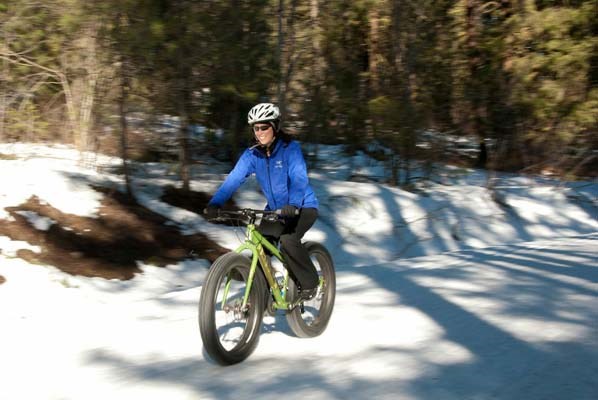Back in November, I wrote about my growing fascination with snow biking and hoped to try out this new (to me) version of one of my favourite activities.
This weekend, I finally got to take a fat bike out on the snow when I found myself in Winthrop, Washington, to cycle the world-famous cross-country ski trails in the Methow Valley.
I want to give a huge shout out to the Methow Valley Sports Trail Association in Washington (especially Kristen Smith) and Methow Cycle and Sport for helping make this happen. The MVSTA opened some of the valleys renowned terrain to fat bikes and the bike store has added fat bikes to its rental fleet. Our initial conversation eventually led me to Winthrop to try it for myself.
For anyone who hasnt been to Winthrop, located about 65 kilometres from the Canadian border south B.C.s Okanagan Valley, its a gem of a town: friendly, with a vibe and appearance thats part wild west, part pioneering settler. It also has an incredible network of ski trails on the mountains above the Methow Valley. It was a fantastic place to try riding a snow bike, especially this late in the season I got to test my rental Salsa Mukluk on everything from hardpack ice in the morning to soft spring snow as the day wore on, riding on trails that ranged from gentle flats to heart-pounding climbs.
Snow biking is both very different and very fun. The great big wheels our bikes were rolling on 3.8 Surly Nate tires pumped up to just 5 PSI, not the more typical 90 to 120 PSI gave the forgiving sensation of a full suspension, combined with incredible traction on almost everything we encountered. (Conversely, on asphalt it was hard to turn the bikes by leaning because the wide tires responded much better when kept upright and steered.)
On the hard-packed trails, the bike felt amazingly secure. Even on the iciest sections, the wheels would hold as long as I picked the easiest gear, span the pedals gently without pumping or forcing them, and kept my weight back. This was just one of a number of downhill techniques that transferred really well to snow biking.
On the occasions that I did wash out the back wheel on steeper, icier descent, the width of the tires made recovery very easy and I rarely had to put a foot down.
Snow biking dials the speed of cycling back a notch but increases intensity in other areas. You have to stay very aware of the surface under your tires, including the grounds density and pitch changes.
I found myself going slower than I was used to and choosing easier gears than I expected, and yet I got a better workout, especially on the uphills. The downhills were a blast that felt more like flying or skiing than biking. The very soft spring snow at the end of the ride was a slushy, slippery blast with a lot of sliding around but no tumbles on the big, steady tires.
Snow biking was a new perspective on a sport I thought I knew inside and out. I would really love to see something similar to the Methow Valley Sports Trail Association start up closer to home next year; the enthusiasm with which snow bikes have been embraced in Winthrop, and the steps taken by the MVSTA to ensure they can be ridden without disrupting the experience of the cross-country skiers (very much evidenced in the cheery greetings we heard from the skiers sharing the trails), speak to how successful a similar scheme could be in Whistler, Squamish, or even on the North Shore.
I know that I, for one, will be looking for opportunities to get back on a fat bike next winter in B.C.
Kay Cahill is a cyclist and librarian who believes bikes are for life, not just for commuting. You can contact or send a comment to kay@sidecut.ca.



